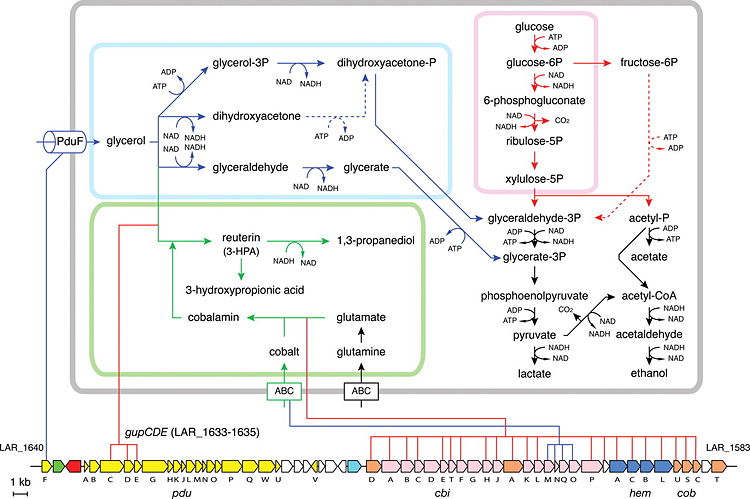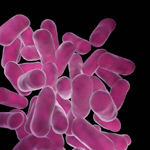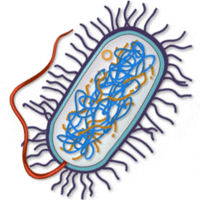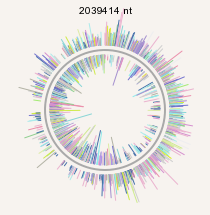Lactobacillus reuteri: Difference between revisions
(New page: ==Classification== Domain; Phylum; Class; Order; family [Others may be used. Use [http://www.ncbi.nlm.nih.gov/Taxonomy/ NCBI] link to find] ===Species=== {| | height="10" bgcolor="#FFD...) |
No edit summary |
||
| (27 intermediate revisions by 3 users not shown) | |||
| Line 1: | Line 1: | ||
{{Curated}} | |||
[[Image:Lactobacillus.jpg|right|300px]] | |||
==Classification== | ==Classification== | ||
Bacteria; Firmicutes; Bacilli; Lactobacillales; Lactobacillaceae; Lactobacillus | |||
===Species=== | ===Species=== | ||
{| | {| | ||
| height="10" bgcolor="#FFDF95" | | | height="10" bgcolor="#FFDF95" | | ||
| Line 10: | Line 12: | ||
|} | |} | ||
'' | ''Lactobacillus reuteri'' | ||
==Description and Significance== | ==Description and Significance== | ||
[[Image:bacteria.png|left|200px]] | |||
Lactobacillus reuteri are Gram-positive, rod-shaped, and anaerobic. These heterofermentatic lactic acid bacterium naturally inhabit the gut of a wide range of organisms, including humans, pigs, chickens and mice [2]. They can also be isolated from human breast milk [10]. In vitro, Lactobacillus reuteri grows optimally on MRS media at 37 degrees Celsius [2]. They have also been found to grow in biofilms [1]. The Food and Agricultural Organization of the United Nations describes probiotics as "live microorganisms which when administered in adequate amounts confer a health benefit on the host," [1] an idea first vocalized by Elie Metchnikoff, in the early 1900's [7]. L. reuteri produces reuterin, an antimicrobial that inhibits growth of harmful bacteria, fungi, and protozoa. Due to these probiotic properties, L. reuteri is believed to be a promising therapy for the alleviation and reduction of certain illnesses related to gastrointestinal health, oral health, and urogenital health, including infantile colic, eczema, and H. pylori infection [1]. | |||
==Genome Structure== | ==Genome Structure== | ||
[[Image:ncgraph.fcgi.png|right|300px]] | |||
The genome of the strain JCM1112 was fully sequenced at Kitasato Institute for Life Sciences by April 21, 2008. The genome contains one circular chromosome and does not contain any plasmids. The entire genome is 2,039,414 nucleotides long, with a GC content of 38%. The genome contains 1901 genes, 83% of which are protein coding. The chromosome contains 1,820 open reading frames (ORFs), 53 of which are phage related [9]. Strain JCM 1112's genome content is strinkingly similar to that of L. fermentum IFO, strain 3956. Comparative analysis of rRNA sequence from all lactobacilli, whose genomes have been sequenced, show that these two species constitute a distinct group. Strain JCM 1112 differs from Strain 3956, as it contains two unique areas, resulting in a 50-kb increase in its genome size. Unique region I contains genes that encode for enzymes involved in glycolysis, while uniqe region II contains genes that encode for nitrate reductase and genes involved in molybdopterin [2]. | |||
==Cell Structure, Metabolism and Life Cycle== | ==Cell Structure, Metabolism and Life Cycle== | ||
Lactobacillus reuteri is a Gram-positive rod that forms chain arrangements and does not produce endospores. Some strains have also been shown to form relatively thin biofilms (5-7µm thick.) [1] L. reuteri is a mutualistic host-associated microbe, living in the guts of animals. As such, it requires a host habitat and is a mesophilic, facultative anaerobe with a preference for acidic environments. L. reuteri is an obligate heterofermentative microbe, producing carbon dioxide, ethanol, acetate, and lactic acid from glucose fermentation. It can also anaerobically metabolize glycerol, producing the antimicrobial reuterin (3-hydroxypropionaldehyde). [2] L. reuteri has also been shown to produce folate and cobalamin, also known as vitamin B12, nutrients that many animals, including humans, require. | |||
Figure 1: Proposed metabolic pathways of Lactobacillus reuteri [2] | |||
[[Image:Reuterimetabolism.jpg|750px|]] | |||
==Ecology and Pathogenesis== | ==Ecology and Pathogenesis== | ||
Lactobacillus reuteri is a naturally occurring component of the animal stomach and intestine microflora. L. reuteri has not been known to be pathogenic; rather, it has been studied as a probiotic organism. L. reuteri produces reuterin by fermenting glycerol. [2] Reuterin is a broad-range antibiotic, affecting both Gram-positive and Gram-negative species, that most pathogenic intestinal bacteria are sensitive to. Studies have shown reuterin produced by L. reuteri is useful against a wide array of harmful bacteria such as pathogenic E. coli strains, Clostridium difficile, Salmonella enterica, Vibrio cholerae, and many others. [3, 4] While it is known how reuterin is produced, the mechanism of how reuterin inhibits growth of such a broad range of pathogenic microbes is still unclear. The antimicrobial ability of L. reuteri is also contributed by its colonization of the epithelial cells, preventing other bacteria from colonizing. Studies have shown that some strains of L. reuteri may prevent Helicobacter pylori infection, the main cause of gastric ulcers, via colonizing competition. [5] | |||
L. reuteri's ability to produce the nutrients folate and vitamin B12 have also been studied as a possible nutritional supplement. Humans require daily intakes of both of these nutrients, and vitamin B12 deficiency has been linked to heart disease, anemia, cancer, and other problems. Vitamin B12 deficiency is particularly prevalent in people with strict vegetarian diets, where supplements of L. reuteri would be useful. [6] | |||
==References== | ==References== | ||
1. Jones, Sara E., Versalovic, James. 2009. "Probiotic Lactobacillus reuteri biofilms produce antimicrobial and anti-inflammatory factors." BMC Microbiology. 9: 35. | |||
2. Morita, Hidetoshi, Toh, Hidehiro, Fukuda, Shinji, et al. 2008. "Comparative Genome Analysis of Lactobacillus reuteri and Lactobacillus fermentum Reveal a Genomic Island for Reuterin and Cobalamin Producion." DNA Research. 15: 151-161 | |||
3. Cleusix, Valentine, Lacroix, Christophe, Vollenweider, Sabine, et al. 2007. "Inhibitory activity spectrum of reuterin produced by Lactobacillus reuteri against intestinal bacteria." BMC Microbiology. 7: 101 | |||
4. Spinler, Jennifer K., Taweechotipatr, Malai, Rognerud, Cheryl L., et al. 2008. "Human-derived probiotic Lactobacillus reuteri demonstrate antimicrobial activities targeting diverse enteric bacterial pathogens." Anaerobe. 14: 166-171 | |||
5. Mukai, Takao, Asasaka Tomoko, Sato, Eri, et al. 2002. "Inhibition of binding of Heliobacter pylori to the glycolipid receptors by probiotic Lactobacillus reuteri." FEMS Immunology and Medical Microbiology. 32: 105-110 | |||
6. Santos, Filipe, Wegkamp, Arno, de Vos, William M., et al. 2008. "High-Level Folate Production in Fermented Foods by the B12 Producer Lactobacillus reuteri JCM1112." Applied and Environmental Microbiology. 74: 10 | |||
7. <http://encarta.msn.com/encyclopedia_761562863/elie_metchnikoff.html>. | |||
8. <http://www.usprobiotics.org>. | |||
9. <http://www.ncbi.nlm.nih.gov/sites/entrez?Db=genome&Cmd=ShowDetailView&TermToSearch=22206>. | |||
10. Sinkiewicz G, Nordström EA. Occurrence of Lactobacillus reuteri, lactobacilli and bifidobacteria in human breast milk. Pediatr Res 58:415, abstract 353. | |||
==Author== | ==Author== | ||
Page authored by | Page authored by Lisa Wallace and Angelica Tovar, students of [http://www.kbs.msu.edu/faculty/lennon/ Prof. Jay Lennon] at Michigan State University. | ||
Latest revision as of 15:17, 7 July 2011
Classification
Bacteria; Firmicutes; Bacilli; Lactobacillales; Lactobacillaceae; Lactobacillus
Species
|
NCBI: Taxonomy |
Lactobacillus reuteri
Description and Significance
Lactobacillus reuteri are Gram-positive, rod-shaped, and anaerobic. These heterofermentatic lactic acid bacterium naturally inhabit the gut of a wide range of organisms, including humans, pigs, chickens and mice [2]. They can also be isolated from human breast milk [10]. In vitro, Lactobacillus reuteri grows optimally on MRS media at 37 degrees Celsius [2]. They have also been found to grow in biofilms [1]. The Food and Agricultural Organization of the United Nations describes probiotics as "live microorganisms which when administered in adequate amounts confer a health benefit on the host," [1] an idea first vocalized by Elie Metchnikoff, in the early 1900's [7]. L. reuteri produces reuterin, an antimicrobial that inhibits growth of harmful bacteria, fungi, and protozoa. Due to these probiotic properties, L. reuteri is believed to be a promising therapy for the alleviation and reduction of certain illnesses related to gastrointestinal health, oral health, and urogenital health, including infantile colic, eczema, and H. pylori infection [1].
Genome Structure
The genome of the strain JCM1112 was fully sequenced at Kitasato Institute for Life Sciences by April 21, 2008. The genome contains one circular chromosome and does not contain any plasmids. The entire genome is 2,039,414 nucleotides long, with a GC content of 38%. The genome contains 1901 genes, 83% of which are protein coding. The chromosome contains 1,820 open reading frames (ORFs), 53 of which are phage related [9]. Strain JCM 1112's genome content is strinkingly similar to that of L. fermentum IFO, strain 3956. Comparative analysis of rRNA sequence from all lactobacilli, whose genomes have been sequenced, show that these two species constitute a distinct group. Strain JCM 1112 differs from Strain 3956, as it contains two unique areas, resulting in a 50-kb increase in its genome size. Unique region I contains genes that encode for enzymes involved in glycolysis, while uniqe region II contains genes that encode for nitrate reductase and genes involved in molybdopterin [2].
Cell Structure, Metabolism and Life Cycle
Lactobacillus reuteri is a Gram-positive rod that forms chain arrangements and does not produce endospores. Some strains have also been shown to form relatively thin biofilms (5-7µm thick.) [1] L. reuteri is a mutualistic host-associated microbe, living in the guts of animals. As such, it requires a host habitat and is a mesophilic, facultative anaerobe with a preference for acidic environments. L. reuteri is an obligate heterofermentative microbe, producing carbon dioxide, ethanol, acetate, and lactic acid from glucose fermentation. It can also anaerobically metabolize glycerol, producing the antimicrobial reuterin (3-hydroxypropionaldehyde). [2] L. reuteri has also been shown to produce folate and cobalamin, also known as vitamin B12, nutrients that many animals, including humans, require.
Figure 1: Proposed metabolic pathways of Lactobacillus reuteri [2]

Ecology and Pathogenesis
Lactobacillus reuteri is a naturally occurring component of the animal stomach and intestine microflora. L. reuteri has not been known to be pathogenic; rather, it has been studied as a probiotic organism. L. reuteri produces reuterin by fermenting glycerol. [2] Reuterin is a broad-range antibiotic, affecting both Gram-positive and Gram-negative species, that most pathogenic intestinal bacteria are sensitive to. Studies have shown reuterin produced by L. reuteri is useful against a wide array of harmful bacteria such as pathogenic E. coli strains, Clostridium difficile, Salmonella enterica, Vibrio cholerae, and many others. [3, 4] While it is known how reuterin is produced, the mechanism of how reuterin inhibits growth of such a broad range of pathogenic microbes is still unclear. The antimicrobial ability of L. reuteri is also contributed by its colonization of the epithelial cells, preventing other bacteria from colonizing. Studies have shown that some strains of L. reuteri may prevent Helicobacter pylori infection, the main cause of gastric ulcers, via colonizing competition. [5]
L. reuteri's ability to produce the nutrients folate and vitamin B12 have also been studied as a possible nutritional supplement. Humans require daily intakes of both of these nutrients, and vitamin B12 deficiency has been linked to heart disease, anemia, cancer, and other problems. Vitamin B12 deficiency is particularly prevalent in people with strict vegetarian diets, where supplements of L. reuteri would be useful. [6]
References
1. Jones, Sara E., Versalovic, James. 2009. "Probiotic Lactobacillus reuteri biofilms produce antimicrobial and anti-inflammatory factors." BMC Microbiology. 9: 35.
2. Morita, Hidetoshi, Toh, Hidehiro, Fukuda, Shinji, et al. 2008. "Comparative Genome Analysis of Lactobacillus reuteri and Lactobacillus fermentum Reveal a Genomic Island for Reuterin and Cobalamin Producion." DNA Research. 15: 151-161
3. Cleusix, Valentine, Lacroix, Christophe, Vollenweider, Sabine, et al. 2007. "Inhibitory activity spectrum of reuterin produced by Lactobacillus reuteri against intestinal bacteria." BMC Microbiology. 7: 101
4. Spinler, Jennifer K., Taweechotipatr, Malai, Rognerud, Cheryl L., et al. 2008. "Human-derived probiotic Lactobacillus reuteri demonstrate antimicrobial activities targeting diverse enteric bacterial pathogens." Anaerobe. 14: 166-171
5. Mukai, Takao, Asasaka Tomoko, Sato, Eri, et al. 2002. "Inhibition of binding of Heliobacter pylori to the glycolipid receptors by probiotic Lactobacillus reuteri." FEMS Immunology and Medical Microbiology. 32: 105-110
6. Santos, Filipe, Wegkamp, Arno, de Vos, William M., et al. 2008. "High-Level Folate Production in Fermented Foods by the B12 Producer Lactobacillus reuteri JCM1112." Applied and Environmental Microbiology. 74: 10
7. <http://encarta.msn.com/encyclopedia_761562863/elie_metchnikoff.html>.
8. <http://www.usprobiotics.org>.
9. <http://www.ncbi.nlm.nih.gov/sites/entrez?Db=genome&Cmd=ShowDetailView&TermToSearch=22206>.
10. Sinkiewicz G, Nordström EA. Occurrence of Lactobacillus reuteri, lactobacilli and bifidobacteria in human breast milk. Pediatr Res 58:415, abstract 353.
Author
Page authored by Lisa Wallace and Angelica Tovar, students of Prof. Jay Lennon at Michigan State University.



